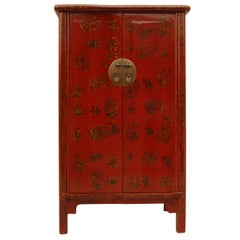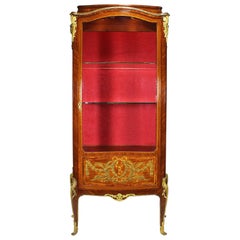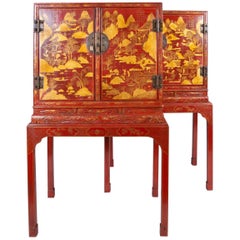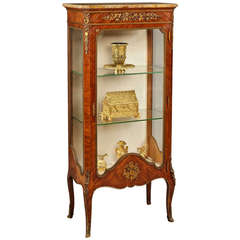Early 1900s Cabinets
2
to
1
2
2
2
2
1
3
27
25
32
11
9
4
2
2
2
3
3
2
1
Height
to
Width
to
Depth
to
1
1
1
1
1
1
1
1
1
1
Period: Early 1900s
Color: Red
Red Lacquer Cabinet with Gilt Motif
Located in Greenwich, CT
Red lacquer cabinet with gilt motif with inside two drawers shelf and bottom space. We carry fine quality furniture with elegant finished and has been appea...
Category
Chinese Chinoiserie Antique Early 1900s Cabinets
Materials
Lacquer
19th-20th Century Marquetry and Gilt-Bronze Mounted, François Linke Atrributed
Located in Los Angeles, CA
A fine French 19th-20th century kingwood and tulipwood marquetry and gilt-bronze mounted vitrine, in the manner of François Linke (1855-1946). The slender single door display cabinet with a red-velvet backing and bowed glass panels surmounted with acanthus and floral gilt-bronze mounts in the style of Léon Messagé (French, 1842-1901), the serpentine shaped front door with an ornate marquetry and ink colored panel depicting wreaths, ribbons and tied acantus leaves, all raised on four cabriolet legs ending with gilt-bronze paw-feet, Paris, circa 1900.
Linke was born on 17 June 1855 in the small village of Pankraz, in what is now the Czech Republic. Records show that Linke served an apprenticeship with the master cabinet maker, Neumann, which he completed in 1877. Linke’s work book or Arbeits-Buch records that he was in Vienna from July 1872 to October 1873 at the time of the International Exhibition held there in 1873.
He subsequently travelled to Prague, Budapest & Weimar before finally arriving in Paris in 1875. It is documented that he obtained employment with an unknown German cabinetmaker in Paris, and stylistic similarities, photographs and geographical proximity have led some to suggest that Emmanuel Zwiener was the most likely candidate. After a period back in his home town of Pankratz, he returned once and for all to Paris in 1877. In 1878 Paris hosted the third great International Exhibition, a remarkable success for a country ravaged by war only seven years earlier. It is known that the fledgling Linke workshops were active in the Faubourg St. Antoine as early as 1881, during this time he supplied furniture for other more established makers such as Jansen and Krieger.
By 1889 another World’s Fair, as they were often referred to in America, took place in Paris. Monsieur Eiffel erected what has become the most iconic building in Paris for the exhibition and the atmosphere of wealth and confidence may well have encouraged Linke to think that he could contribute an important part to the next great exhibition. As early as 1892 this was decreed to take place at the end of the century, in an attempt to pre-empt Berlin from staging the last great show of the century.
In 1892, Victor Champier (fr) one of the commissioners for the 1900 Paris Fair had appealed, “Create in the manner of the masters, do not copy what they have made”. It was an appeal against mere reproduction and Linke rose to this challenge in an unparalleled way with his unique display that was to include the Grand Bureau.
Determined to outshine the competition at the Exhibition, Linke had set about creating the most ambitious pieces he could envisage, and more extravagant than had ever been displayed before. The items he exhibited marked a transition from the historicist interpretation of Louis XV and Louis XVI styles, an interpretation that was the mainstay of his nearest rivals, to something startlingly new and vital in its immediacy. [6] Together with Léon Messagé he developed a new style for the 1900 Exhibition that paid homage to the Louis XV rococo in the fluidity of its approach, but an approach fused with the lively flowing lines of the contemporary and progressive 'art nouveau'. The Art Journal reported in 1900 on Linke's stand:
"The work of M. Linke ... was an example of what can be done by seeking inspiration amongst the classic examples of Louis XV and XVI without in any great sense copying these great works. M. Linke's work was original in the true sense of the word, and as such commended itself to the intelligent seeker after the really artistic things of the Exhibition. Wonderful talent was employed in producing the magnificent pieces of furniture displayed".
Linke's stand would have appeared refreshingly new to contemporary onlookers, the traditional designs of the eighteenth century melting seamlessly into an exuberant naturalism. The 'Revue' described Linke's style as 'entièrement nouveaux' and noted "This opinion is universally accepted. Linke's stand is the biggest show in the history of art furniture in the year 1900". It is perhaps the most extraordinary and remarkable aspect of Linke’s personal history that he produced such expensive and luxurious furniture of exquisite quality for the 1900 exhibition without any commission or any potential buyer in mind. [9] At a time when other more established furniture businesses such as those of Beurdeley and Dasson were closing down, he made a huge investment in his stand and the furniture he supplied for it. Linke recognised that to move his business forward he needed to appeal to a more International clientele and the new emerging rich who were at this time amassing fortunes on an unprecedented scale. For this reason he gambled everything he had on his display for the 1900 exhibition. Had this not succeeded he would almost certainly have succumbed to bankruptcy. Linke’s notebook records visitors to his stand from England, Europe, the Americas, Egypt and Japan and including; the King of Sweden, three visits from the King of Belgium, Prince Radziwill, the Prince d’Arenberg, the Comte Alberic du Chastel, Miss Anna May Gould, the American heiress, distinguished furniture makers and the President of France Emile Loubet.
This risky endeavour was a resounding success, and with his reputation established, La Maison Linke became the pre-eminent furniture house until outset of the Second World War. The technical brilliance of his work and the artistic change that it represented was never to be repeated. His showrooms expanded into prestigious premises in Paris, in the Place Vendôme as well as the Faubourg St. Antoine where his workshop had been established. He embarked on many important commissions in the years up to the outbreak of the First World War, making and designing furniture for leading international industrialists and bankers. After the 1914-1918 World War, Linke undertook the extraordinary commission to furnish the Ras al-Tin Palace in Alexandria for King Fuad of Egypt, possibly the largest single furniture commission ever conceived, eclipsing even Versailles. Linke flourished and remained active until the middle years of the 1930s and died in 1946
Léon Messagé (1842-1901) was a French sculptor, best known for his sculptural collaboration with François Linke for the 1900 Paris Exposition Universelle. Messagé was also responsible for much of the design and creative work for Roux et Brunet...
Category
French Louis XV Antique Early 1900s Cabinets
Materials
Bronze
Related Items
Pair of Chinese Export Bronze-Mounted Red Lacquer and Parcel-Gilt Cabinets
Located in Hudson, NY
On later stands, each fitted with a pair of cabinet doors opening to shelves. Loose translation of the calligraphy across the four doors reads:
"Going tens of miles in Jiangnan in ...
Category
Chinese Antique Early 1900s Cabinets
Materials
Lacquer
H 60.5 in W 36.25 in D 24 in
19th Century French Vitrine of Kingwood and Gilt Bronze Mounts
Located in London, GB
A fine vitrine in the manner of Francois Linke
Constructed in kingwood, with gilt bronze mounts, in the Louis XVI Transitional style; rising from bronze foliate sabots, with gent...
Category
French Louis XVI Antique Early 1900s Cabinets
Materials
Marble, Bronze
Chinese Qing Dynasty Ningbo Red Lacquered Cabinet with Butterfly Hardware
Located in Yonkers, NY
A Chinese Qing Dynasty Ningbo red lacquered four-door wedding cabinet from the 19th century, with butterfly hardware. Created in Eastern China durin...
Category
Chinese Antique Early 1900s Cabinets
Materials
Wood
H 75.25 in W 54.5 in D 30 in
Chinese Qing Red-Lacquered Cabinet
Located in Kastrup, DK
A early 19th century qing dynasty cabinet boasting a deep red patina from the Shanxi Province, circa. 1820-1830.
The façade showcases two doors fitted with a traditional round medal...
Category
Qing Antique Early 1900s Cabinets
Materials
Brass
Pair of Chinese Qing Dynasty Black Lacquer Cabinets with Hand Painted Motifs
Located in Yonkers, NY
A pair of Chinese Qing Dynasty period black lacquer display cabinets from the 19th century, with hand-painted décor depicting court scen...
Category
Chinese Qing Antique Early 1900s Cabinets
Materials
Wood
H 45.5 in W 33.5 in D 19.75 in
Chinese Qing Dynasty Red Lacquer Cabinet with Hand-Painted Décor
Located in Yonkers, NY
A Chinese Qing Dynasty period red lacquer cabinet from the 19th century, with hand-painted gilt motifs. Created in China during the Qing Dynasty in the 19th century, this wooden cabinet features a linear silhouette perfectly complimented by a red lacquer ground. The façade showcases two large doors adorned with a delicate hand-painted gilt décor. A landscape made of mountains surrounded by auspicious clouds, trees, architectures and people crossing bridges, sitting at home or riding a boat, decorate those doors. A discreet frieze of foliage on the outer frame surrounds the ensemble. The doors are fitted with a large floral medallion with ornate pulls, and they open to reveal a nicely distressed interior made of two shelves and a hidden compartment. The sides are made of recessed panels with a dark reddish black lacquer while the back is made of brown planked wood. With its clean lines, red lacquer and faint but lovely hand-painted décor...
Category
Chinese Qing Antique Early 1900s Cabinets
Materials
Brass
Chinese Red Lacquer Qing Dynasty Cabinet with Faint Hand-Painted Palace Scenes
Located in Yonkers, NY
A Chinese Qing Dynasty period red lacquer cabinet from the 19th century with faint hand-painted décor and brass hardware. Created in China during the Qing Dynasty period in the 19th ...
Category
Chinese Qing Antique Early 1900s Cabinets
Materials
Brass
H 71.5 in W 46 in D 25.5 in
Chinese Red Painted/Lacquered Cabinet With Flowers, Circa 1820
Located in Round Top, TX
Antique Chinese Red Painted/Lacquered Cabinet. This beautiful red cabinet has lovely flowers and pomegranates displayed on the panels in black and highlighted in gold. The unique pan...
Category
Chinese Antique Early 1900s Cabinets
Materials
Wood, Paint, Lacquer
Chinese Ming-Style Tapered Cabinet with Original Red Lacquer
Located in Kastrup, DK
Mid-19th century Chinese tapered cabinet. Original red lacquer.
Pair of doors fitted with bronze lock opens to reveal a shelved interior, fitt...
Category
Chinese Ming Antique Early 1900s Cabinets
Materials
Brass
Chinese Red Lacquer Ming Dynasty Style Cabinet with Floral-Carved Gilt Apron
Located in Yonkers, NY
A Chinese Ming Dynasty style red lacquered cabinet from the 19th century, with four drawers, ornate brass hardware and carved apron. Created in China during the Qing Dynasty, this Ming style cabinet...
Category
Chinese Qing Antique Early 1900s Cabinets
Materials
Brass
H 72.75 in W 39 in D 25.5 in
Chinese Red Lacquer Cabinet with Display Shelf
Located in Rio Vista, CA
Impressive Chinese red lacquer cabinet with an open display shelf. Featuring an aged red lacquer finish and intricate carved fretwork decoration on the front panel. The case has two ...
Category
Chinese Qing Early 1900s Cabinets
Materials
Brass
Two Vernis Martin and Gilt Bronze Mounted Display Cabinets by Linke
Located in London, GB
These elegant display cabinets (or vitrines) were crafted in the late 19th century by the leading ébéniste (cabinetmaker) of the period, François Linke (French, 1855-1946). Linke was...
Category
French Louis XVI Antique Early 1900s Cabinets
Materials
Bronze, Ormolu
Recently Viewed
View AllMore Ways To Browse
Brass Vintage Display Cabinet
Tall Mirrored Storage Cabinet
Antique Open Shelving
Antique Filing Cabinets
Antique Filing Cabinet Antiques
Antique File Cabinets
London Display Cabinet
Japanese Style Storage
Antique Filing Cabinet
Antique File Cabinet
Antique Vine Cabinet
Retro Polished Steel Cabinet
19th Century French Green Cabinet
Filing Cabinet Antique
Regency Inlaid Cabinet
Wood Storage Container
Filing Cabinets Antique
File Cabinets Antique



